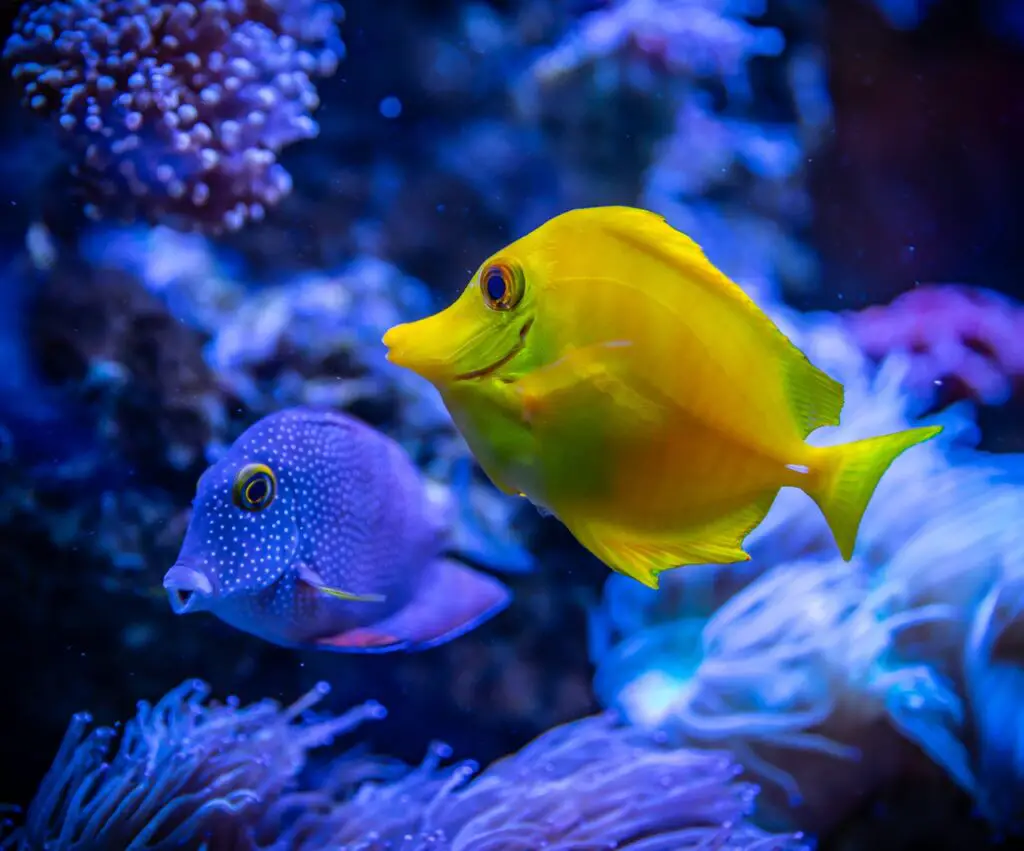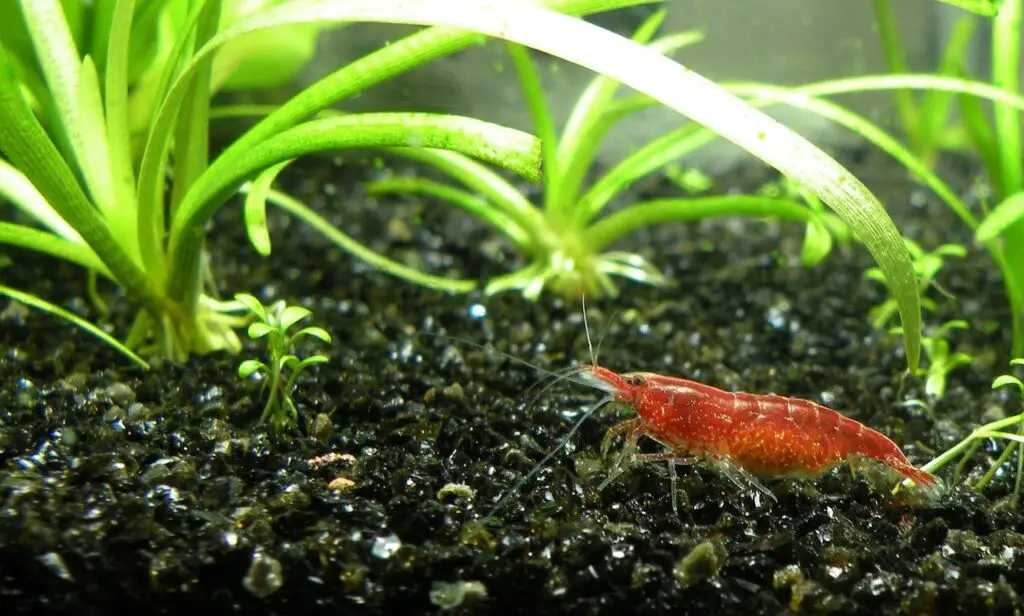Have you ever considered keeping a brackish fish tank before? Are you looking at different tropical fish, and are seeming to spot more and more attractive fish that love brackish waters?
If you’re new to tropical fish keeping in any shape or form, you might wonder what the difference is between the many types of tank and water. Why is it that you can only house certain species of fish in one tank and not in alternative types?
Fish keeping might not be as simple as just filling a tank or a bowl with water and placing a fish in it, but that doesn’t mean it has to be complex. If anything, fish keeping is all the more rewarding because it takes a lot of attention and consideration. It really feels as though you are making a difference to the lives of your pets!
So – in this guide we are going to take a look at the 14 coolest brackish water aquarium fish you will find widely available to buy and adopt into your aquarium right now. You can always click through to our full guides on each fish too if you would like to learn more, and remember, as fish keepers we can never really stop learning!
What is Brackish Water?
Brackish water is the middle point between freshwater and saltwater, or marine water that you find in the sea. Essentially, this means that brackish water is saltier in content than freshwater, but less salty than marine water. The differing levels of salt and PH levels mean that there are equally differing types of marine life that have adapted to life in each.
Brackish water tends to have a broad range in terms of having the perfect pH balance and the perfect hardness level. Of course, what is ideal for one fish will not always be ideal for another. That is why keeping a brackish tank is one step up from a freshwater model. It is arguably more difficult to keep water brackish than it is to keep it fresh. This is the reason why we always recommend looking into a brackish tank or aquarium setup if you are thinking of moving from freshwater to marine. It is the midpoint between the two standards.
What is really interesting is the fact that there are some fish that will happily move between both freshwater and brackish waters, and some that move between brackish and marine water. It is always worth doing your research on these fish if you are considering switching fish from one to the other.
We have compiled more detailed information into this guide and our separate profiles on the coolest brackish fish for your aquarium. Keep reading to find out more.
Why Should I Get a Brackish Aquarium?
A brackish aquarium is, for many fish keepers, that important second step on their tank advancement journey.
It is still challenging keeping freshwater fish, but brackish water, as we mentioned earlier, needs a little more attention when it comes to salinity and the various levels demanded by the fish that reside there.

One of the best reasons for investing in a brackish aquarium means that you will effectively open up your home to more types and species of fish that you might not have had access to previously. Exotic species in the Pufferfish family, for example, are largely brackish. What is more, you will be able to introduce wonderful creatures like the Dragon Goby and the Sailfin Molly into your marine community.
The pH levels and salinity demands for a brackish tank tend to be fairly broad. Arguably, it may be easier for a beginner fish keeper to adjust to a brackish system over a full marine system. However, keeping a brackish aquarium still means you need to keep a keen eye on everything that is going on behind the glass. There are some fish that are so sensitive, even the slightest changes in water levels could lead to illness, or even death in some cases! So do make sure to do a little bit of reading on brackish fish and tanks before you dive fully into the experience.
13 Brackish Water Aquarium Fish We Recommend
Ready to start filling your new brackish community? Of course you are. It can be argued that the brackish tank enthusiast is likely to find a broader range of fish for that type of community than for any other, as there are many saltwater and freshwater fish that can cross over into the middle point.
If you really have your heart set on creating the most vivid, eye-catching and astonishing tank around, you really can’t do any harm by adding a brackish fish or two into the mix.
Here are 13 brilliant species we think will do wonderfully well in your brackish tank. We’ve gone into some detail here as an introduction, but don’t forget, you can click through on each fish and read more about them in their own full profiles and guides on our site.
Guppy
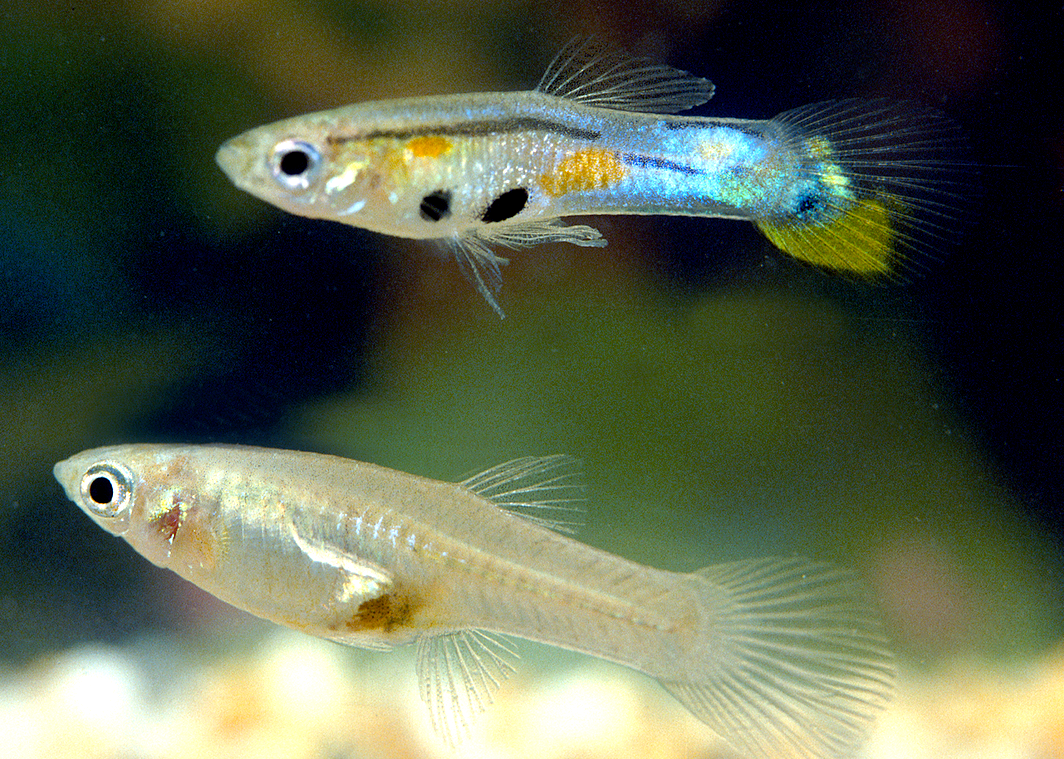
The Guppy is easily one of the most recognisable tropical fish that love brackish waters. Endlessly colourful they bring a cheerful look to your tank and are compatible with even some of the more aggressive species out there. A guppy is likely to be a simple introduction to brackish tank keeping. With a basic 20 gallon tank to start off with, you can cast in 10 to 12 guppies – but, as always, it makes sense to hold out for a bigger tank if you can.
Guppies tend to swim the line between timidity and aggression, making them a reasonably happy, content species of fish that is also a lot of fun to watch and keep. However, they do have very specific water demands, which means – as always – you are going to need to keep a close eye on salinity, temperature, hardness and more.
There are many, many different types of Guppy out there which suggests that the Guppy is likely one of the most prolific of brackish fish out there – they are extremely easy to breed! They need very little encouragement, which is why you often end up cramming a tank full of them if you are not careful.
However, tiny Guppy life is often easy prey for bigger fish that love meaty morsels. Therefore, always take care when it comes to bringing Guppies into the community. Your best option, in our collective opinion, is to bring Guppies into an environment where they can swim happily alongside similarly sized fish of a similar temperament.
We think Guppies are great fish for new brackish keepers as they are so straightforward and so fairly undemanding. They are also incredibly placid and never act up, meaning you can never expect too much drama from a Guppy. As for some of the other fish on this list – well, you’ll soon see.
Black Molly
There are tons of different Mollies in the world, and the Black Molly is often one of the more common aquarium picks. These fish tend to be fairly small and grow up to three to four inches in length. Like the Guppy, the Black Molly is reasonably friendly, which means you do not have to expect drama from them every five minutes. They even do well with Angelfish, who you may know can have a bit of an attitude to them if given half the chance!
The Black Molly will normally do well in a tank that’s at least 10 gallons in size to begin with. Black Mollies can get a bit tetchy with one another if there are males trying to muscle in on territories, or if they are in pursuit of females in the tank. Therefore, you might need to be extra careful in terms of the size of the Black Molly group you introduce, just so to reduce the likelihood of any getting stressed out.
Black Mollies are really popular with brackish tank owners for their taste for algae, too. The Black Molly is a consummate omnivore, scooping up just about everything it likes for dinner. This means you’ll be able to freely feed it on frozen food as well as bits of vegetation. Algae is a real nuisance in some brackish tanks, which means having help with cleaning up occasionally from a Black Molly is a real boon.
Black Mollies aren’t always the hardiest of fish, meaning that they can succumb to a few common diseases. Make sure to discuss any concerns and questions you may have about this species with a vet or a fish keeping expert before you start bringing them into your community. Otherwise, you can expect a happy, healthy swimmer providing you give them the best tank conditions.
Sailfin Molly

Sailfin Mollies also make great first time brackish tank dwellers, meaning that they have great attitudes on the whole, and they are not some of your more demanding community members. They are some of the most vibrant and colourful Mollies around too. Much like the Black Molly, the Sailfin follows a similar pattern in terms of aggression level and in terms of feeding or tank demands.
The main difference between the Sailfin and Black Mollies lies in the fact that the Sailfin Molly is likely to be much larger, and is likely to have brighter, more striking patterns. That doesn’t mean you should ever overlook the Black Molly, though! In some cases, you can keep Mollies together in the same tank, and many brackish fish keepers have successfully bred them to create hybrids.
Sailfin Mollies are normally pretty hardy, also in the wild, though they, like other brackish fish, can find themselves at risk of all kinds of nasty marine conditions. On top of that they are sadly likely to get eaten at birth more than anything else.
Sailfin Mollies will happily live with other fish and creatures such as Guppies, but they may find themselves in direct competition. Sailfin Molly fish can nip other fish occasionally, too, which means you will need to carefully consider them as part of your brackish community. If you have fish in your tank that are fairly sensitive or prone to stress, then it may be best to keep the Sailfin well away.
Other than that, you can expect this type of fish to be a fantastic pick for most brackish aquariums. Keep in mind that they are some of the bigger Mollies around, so as usual you are going to need to aim for a bigger tank than you initially plan for if you want to keep a larger collection.
Four Eyed Fish
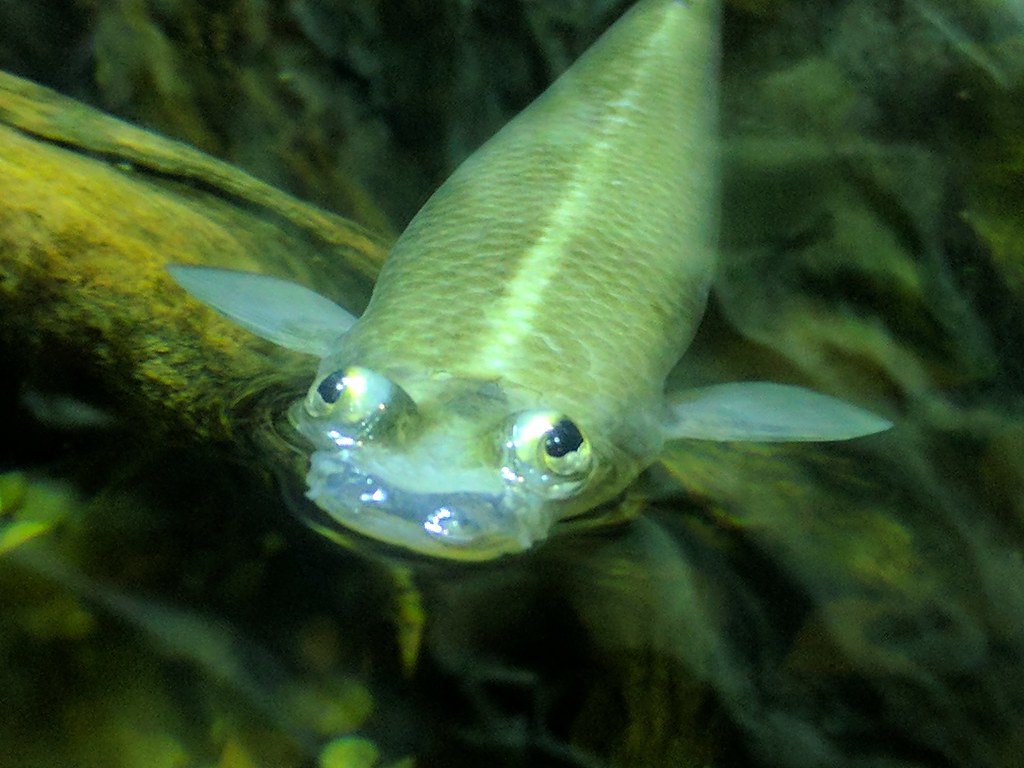
The Four Eyed Fish, also known by its Latin name as Anableps, is a curious creation. It has two eyes, much like every other brackish fish, but it has a strange membrane system that allows each of its eyes to split into two. This makes the Anableps one of the most eagle-eyed creatures in the brackish tank, meaning it’s very hard to sneak up on.
These fish are surface swimmers, which means you’re going to need to prepare your tank properly so that it can bob up and down as and when it pleases. It is also a good idea to keep a cover to hand, too, if you are worried about a cat taking a swipe at these fish occasionally.
Four Eyed Fish can live for up to a good eight years in captivity, and during that time, you are certainly going to want to serve it a fair mix of meaty goodness. It’s a carnivore, which means that while your Anableps are going to be able to spot any algae you have growing in your tank thanks to its amazing vision, they will never eat any of it. It’s normally a good plan to keep your Anableps fed on live bait.
Tank sizes for the Anableps, of course, should be of generous volume. Once again, the bigger the tank, the better. The Four Eyed Fish is normally going to get on well with Sailfin Mollies, and its water demands otherwise fall well within what you’d normally expect from other brackish creatures. That said, this fish will thrive more if you change out around 20% of it’s water every fortnight. This fish is strange, but true and amazing to view – and who are we to argue with a fish that can see in 360 degrees?
American Flagfish
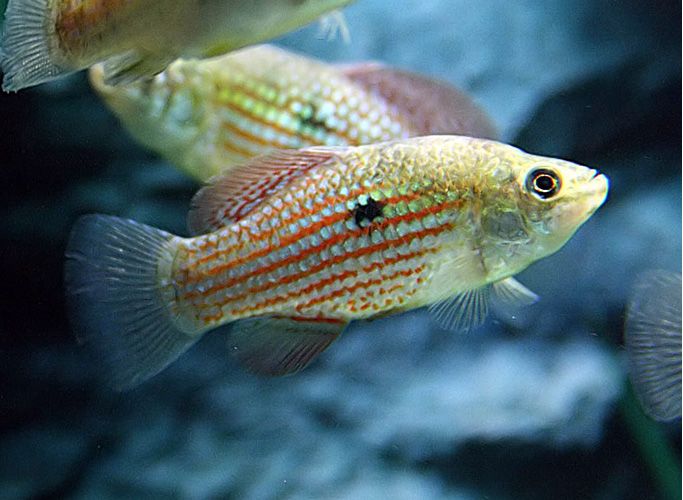
Yes – if its name wasn’t a giveaway, the American Flagfish does look a little bit like the Stars and Stripes. The stars, in fact, are really easy to spot on their scales – and their stripes happen to be the right colour for the US flag, too. This really is a miracle of nature – and a great brackish pick if you’re looking for a colourful critter with a touch of patriotism thrown in. It’s actually a type of Killifish and is often referred to as just a ‘Flagfish’ in general fish keeper talk!
It’s a fantastic beginner’s choice, on the whole, mainly because it has a mild demeanour, doesn’t grow to much larger than three inches in length, and doesn’t demand too much from you. Providing you have a large tank with lots of spots for the Flagfish to scurry away and hide in, you most likely won’t have much to worry about.
The Flagfish is another brackish community member that enjoys a bit of a varied diet, meaning you can easily feed it on shrimp as well as vegetation. This also means you’re going to need to make sure this fish doesn’t try eating any smaller critters in its way. It might not be that big on its own, but if you place it in a tank with, say, a Bumblebee Goby, that Goby is straight on the menu. Don’t risk it – look for fish that have similar temperaments and who are around the same bulk.
Overall, we would really recommend the Flagfish to brackish beginners. Largely thanks to the fact that it has such a striking look, and the fact that they are seriously undemanding. They make a great introduction to the brackish waters, and we seriously suggest you adopt these critters before any others. Not that we are biased!
Colombian Shark Catfish
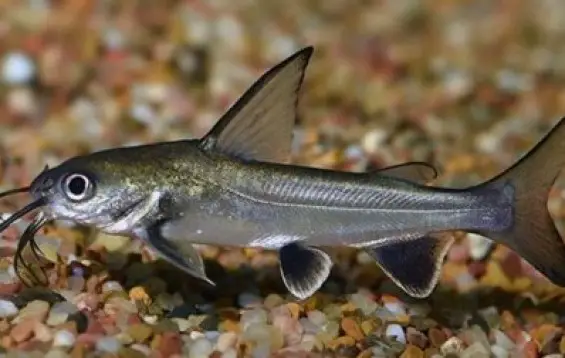
The Colombian Shark Catfish is a bizarre but brilliant brackish tank addition, fantastic for those fish keepers who want a lively and brutish looking beast that swims like a shark! In fact, the way this fish swims is largely the only thing that it shares with its namesake. What’s more, its fearsome look, swimming style and name really don’t go with this critter’s true nature.
The Colombian Catfish is famous for being pretty docile and having a really mild-natured temperament and these fish also tend to make great exotic pets for larger tanks. As with many Catfish, this beast has the capacity to grow to a formidable size, meaning that you may be looking at up to 10 inches per fish! That’s a lot of room to make. What’s more, this fish is normally sold at half this size at stores, meaning newbie fish owners are often fooled into underestimating how big these will get.
It’s therefore a good idea to either have a big tank for this fish – ideally 50 gallons or more – or two separate communities. These fish do propagate and breed well, meaning that if you release their young into the same tank as many of your other smaller fish, you are likely to start running out of space pretty sharpish. What’s more, a big Catfish in a tank full of small, meaty fish is a recipe for disaster.
The Colombian Catfish isn’t aggressive, but again, it’s a very good idea to try and keep them away from smaller beasts so that they don’t start swallowing up the neighbourhood any time soon. This, of course, goes for most of the bigger fish in a community tank, so this probably isn’t a rule that’s totally new to you!
Berneys Shark Catfish
The Berneys Shark Catfish is a sizeable beast that’s going to be with you for more than a decade – providing you look after it well! The Berneys Catfish is a great community companion, has a brilliant attitude, and like other Catfish, is marked for its strong-looking whiskers. These fish thrive in light conditions for much of the day, so if your aquarium has a lighting feature, you are going to want to crank up the illumination between the normal daylight hours. This is what this fish would expect in the wild.
The Berneys Catfish tends to be a little picky on the diet side of things, so don’t always expect it to chow down on your algae or to join in on those fish flakes. However, it is an omnivore, which means it has an active interest in most kinds of food available to it. However, it has a particular taste for shellfish, meaning if your tank is home to smaller crabs, you’re going to need to move them. This Catfish plays well with others, but anything smaller than itself is automatically going to look very tasty to it. Caution is advised!
This brackish fish is also one of the cleverest you may come across for your home tank. The Berneys Catfish has evolved to use tools! That is, it will use its teeth to break open shells, and will actually endeavour to keep them looking and working great. The Berneys Catfish really is a smart little dentist, though there’s nothing little about it – they can grow up to be more than a foot long!
This Catfish is generally pretty laid back, but given its size and its tastes, and the fact that it will fight back if anything dares to nip at its fins, this is a creature we’d recommend to intermediate brackish tank owners.
Pufferfish
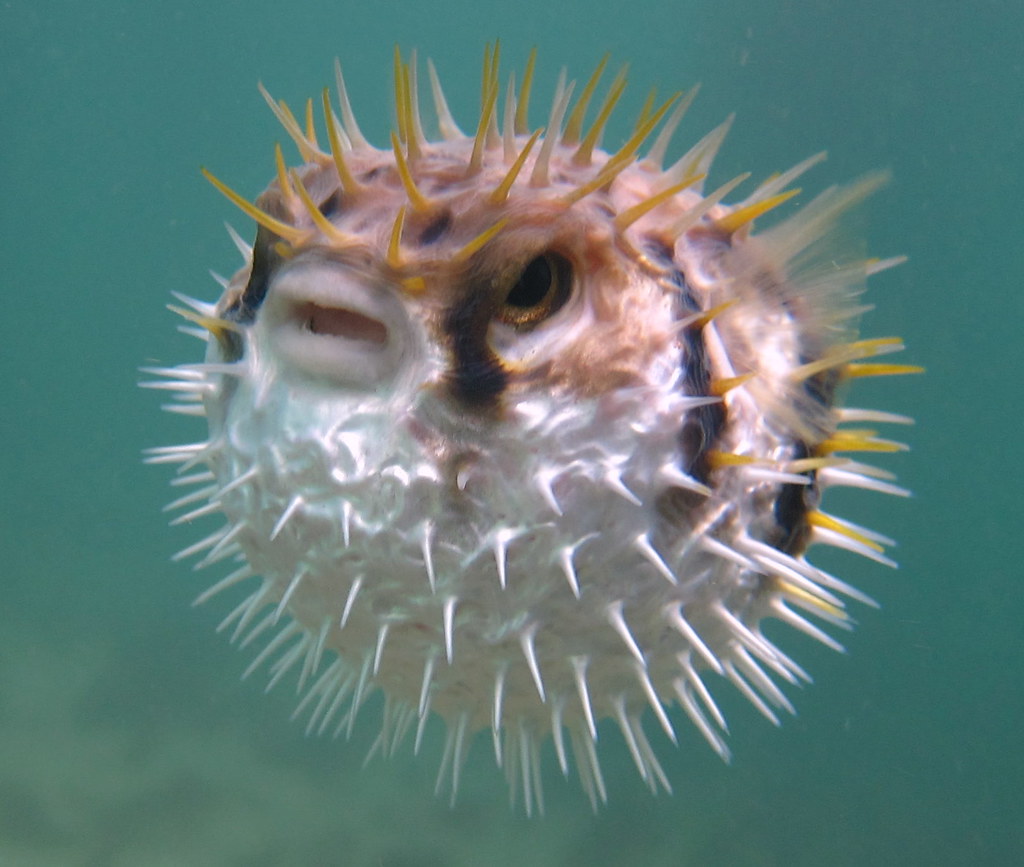
The Pufferfish is an iconic animal, best known for inflating itself in self defence when it feels threatened! However, many Puffers are covered in toxic spines, making them dangerous both for fish keepers as well as other members of the community. There are more than a hundred different types of Puffer out there (there’s a specific one listed for you below), but all of them have much the same character – feisty, tenacious, and ready to blow up at a hair’s breadth.
The Pufferfish is a food machine! While small, this little beast is great at scooping up all kinds of food. They enjoy vegetation as well as meat, making them brackish omnivores. It’s best to try and balance this diet out with quality food, of course. The Puffer is likely to nibble on anything smaller than itself, so always be ready to separate them.
In fact, it’s very likely you will need to separate Puffers from the community altogether if you intend to let them thrive. That’s because they can be both aggressive and defensive, making them very stressful for more timid fish to live alongside. While it’s not impossible for other fish to live with a Puffer in the community, it’s a challenge for any fish keeper to try and keep everyone happy and safe. Therefore, we often recommend you try and separate these fish and raise them on their own in a specific tank.
Pufferfish are toothy beasts, and while they may look small to begin with, remember that they puff up and inflate! Therefore, while it might seem as though a small tank is going to be enough for them, take into account inflation space, too. This means that – once again – bigger is definitely better when it comes to tank sizing.
Green Spotted Puffer

The Green Spotted Puffer is just one of the variants of Pufferfish out there, and available for you to adopt for your own brackish tank. As stated above, Green Puffers have slight attitudes to them, and will give as good as they get. They are also some of the trickier fish to look after in a brackish tank, meaning we would normally recommend these characters to tank keepers who have a few years of experience behind them.
This Puffer is so-named, of course, for the simple fact that it is green spotted! That’s really all there is to it! This is a wild Pufferfish, one which is often found out East, and which will normally find its way to adopters carrying various parasites. Therefore, as with other Pufferfish, you should really think about keeping these critters in their own tank. That’s really not a bad thing, as Green Spotted Puffers get on well on their own, and sometimes with others in their species. This doesn’t always follow, of course, so make sure to ask a fish keeper or veterinarian to learn more.
If you do want to try introducing a Green Spotted Pufferfish to your tank, one of the best things you can do is bring them in at the same time as other fish in the community. The Green Puffer will otherwise try either to muscle in or will see anyone new in the tank as a threat. These really are sensitive beasts and deserve special care and attention!
The Green Spotted Puffer is one of the few brackish fish that can cross over into freshwater, though many people suggest that brackish water is better for it. In any case, the agreement is this great-looking fish does well in a species exclusive tank.
Gobies

Gobies are seriously prolific and are often some of the first choices people make when it comes to setting up a brackish tank for the first time. It’s not hard to understand why, as they are fairly mild mannered, and won’t need that much looking after. However, we are of course talking about your common Goby, as – and get this – there are more than 2,000 Goby species out there. That means you really are going to have to narrow down your options. We’ve covered a couple of the most popular brackish tank picks below for you.
Gobies really do vary in terms of size, but temperament wise, they are fairly easy going. That doesn’t stop them preying on other fish, of course, so just because a Goby is docile isn’t going to ensure they treat other members of the community carefully! They get on well with everything from the Colombian Shark Catfish to the Sailfin Molly. Therefore, putting a few Gobies in your tank probably isn’t too far a stretch!
Many do see Gobies as nuisances, though, in wild conditions. These sometimes tiny fish can propagate very quickly, much in the same way Guppies can, and therefore, controlling them can be tricky. That’s why you might want to set up a separate tank for any offspring of a couple of Gobies just to keep them safe – and to ensure that your tank doesn’t get too crowded in the meantime. While they are sometimes invasive in the wild, in the home tank, your average Goby is likely to be very charming and great fun to watch.
There are even some Gobies that can breathe above water! This really is a broad umbrella for an awful lot of brackish fish, so do make sure to take a closer look at types and species that really appeal to you.
Bumblebee Goby

Speaking of Gobies, the Bumblebee Goby happens to be one of the smallest of all amongst this type of fish, and as its name suggests, it’s famous yellow and black striped. While these Gobies won’t fetch you any honey, they do enjoy grouping around, and will only ever get aggressive with each other if things get territorial. On the whole, you can expect the general Goby experience from a Bumblebee, which means you are generally looking forward to a relatively smooth ride!
Ideal for beginners in brackish tank keeping, the Bumblebee Goby is likely to be one of the more exciting additions to your tank. That’s because the Bumblebee Goby scoots around happily and is always likely to add a bit of colour and pizazz! These fish sadly don’t tend to live for all that long, likely to get to around 3 years of age. However, with plenty of good care and the best food, there is nothing to say you won’t be able to encourage your Bumblebee Goby to live for longer!
Of course, the Bumblebee Goby is likely to be under threat from other, bigger fish, mainly because they are so snack-sized! Therefore, it’s always a prudent idea to try and introduce a Bumblebee Gobyto a tank with fish of a similar size and temperament, or into a tank where you have predominantly herbivore fish swimming around. That said, even the Bumblebee Goby is a meat eater, and given its tiny size, it will normally snack on shrimp or anything minute and meaty it will find.
We think the Bumblebee Goby is one of the most charming picks for your brackish tank, and it’s also one of the better choices for beginners, too.
Water Cow Fish

From one of the smallest Gobies to one of the biggest, the Water Cow Goby grows up to 10 inches in length and loves nothing more than just lolling along at the bottom of the tank. These sizeable critters are famously docile and really don’t need that much looking after. Brown to grey in colour, these are rewarding creatures that, again, you will need to watch around other fish.
As with most Gobies, the Water Cow tends to feed on meat, meaning that you will often see this lazy, yet imposing beast happily gulp down a fish or two that happens to float in its direction! Therefore, if you really want to keep the community safe, you should probably keep these critters in their own tank. They tend to get on well with each other, so this shouldn’t really be much of an issue.
The Water Cow Fish needs a lot of space due to its size, but surprisingly, it won’t cause much drama. Many people get these fish thinking that they will be breezes to look after! That might sometimes be the case, but let any smaller fish get in their way, and they are toast. The Water Cow is a delightful fish that’s going to be well at home in any sizeable brackish tank, but just make sure you know what it’s likely to chomp on. We’d recommend this Goby to intermediate owners.
Dragon Goby
Last but not least, the Dragon Goby, or sometimes the Violet Goby, is a delightful ‘prehistoric’ fish that can grow even longer than the Water Cow – these can persist up to more than a foot in length! They are long, dramatic-looking, and are often some of the most distracting creatures you’ll hope to bring to a brackish tank.
As with other Gobies in your brackish tank, you should make sure that the water quality for this particular fish is kept at a certain level. Otherwise, you run the risk of making it fairly ill! The Dragon Goby is likely to thrive well in an environment where they have a nice balance to the substrate, and you shouldn’t also feel too scared about bringing other fish into the tank, either. These fish can sometimes get a bad rap for being aggressive, but the fact is, they are often more docile than people give them credit for.
Dragon Gobies tend to eat all kinds of things, which means you can rely on feeding them a nice mix of meat and vegetables, and that goes for frozen morsels as much as it goes for live meat, too. These Gobies love large tanks, and if you’re not clear on that golden rule of tank sizing by now, you never will be! Make a point of lining up a big tank and you will have room for them to hide and even propagate in. These are some of the most exciting Gobies to watch milling around the tank, so make a point of considering them.
Conclusion and Final Tips
Brackish waters are full of amazing fish, and if you are only used to freshwater or saltwater fish keeping, then you are definitely missing out on a world of colourful, characterful water dwellers. We love brackish tanks simply because you can have an amazing mix of Catfish, Gobies, Pufferfish and more. It really is like bringing the tropical waters back into your own home.
Here are a few final tips we’d like to share about finding brackish fish for your home tank.
- Make sure to take a close look at the exact pH and salinity levels these fish require. Just because many of the cool fish on our list are widely adaptable, doesn’t always mean they are going to be the easiest to look after.
- If you are moving from a freshwater tank to a brackish tank, make sure to look into the different ways you can maintain the levels that these fish desire so they can keep swimming! This might include introducing something simple as a new substrate mix in with any gravel on the tank floor.
- The general rule for tank sizing is that you should account for two inches of volume for every one inch of fish. This is a very general rule, and when you consider something like a Pufferfish that can expand at will, it’s not a rule that is always going to work. Therefore, if in doubt, go for a larger tank. Bigger tanks are better than smaller ones in the sense that brackish fish love to be able to swim around in large spaces and to hide in nooks and crannies.
- Consider compatibility very carefully. We can’t stress this enough! Just because the odd Catfish is docile or non-aggressive doesn’t mean it’s not going to take a nibble out of smaller critters. In fact, the worst thing you can do is introduce a big fish into a tank full of much smaller swimmers. It’s just not going to work.
So – to conclude – while keeping a brackish tank might seem more difficult than, say, keeping a freshwater tank on the surface, it likely won’t take you long to adapt to this way of maintaining an aquarium. After all, brackish fish keeping is a much more varied world than what you might already be used to – so why not take a chance if you already have some experience?
If you’d like to know more about the world of brackish fish keeping, make sure to take a look at our individual profiles for each of the fish we cover in this article. Who knows – you might just find a new favourite in no time at all!


